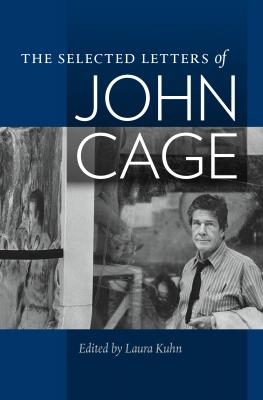The Selected Letters of John Cage. John Cage
Читать онлайн.| Название | The Selected Letters of John Cage |
|---|---|
| Автор произведения | John Cage |
| Жанр | Журналы |
| Серия | |
| Издательство | Журналы |
| Год выпуска | 0 |
| isbn | 9780819575920 |
THE SELECTED LETTERS of
JOHN CAGE
publication of this book is funded by the Beatrice Fox Auerbach Foundation Fund at the Hartford Foundation for Public Giving
THE SELECTED LETTERS of
JOHN CAGE
Edited by Laura Kuhn
Wesleyan University Press | Middletown, Connecticut
WESLEYAN UNIVERSITY PRESS
Middletown CT 06459
© 2016 John Cage Trust
All rights reserved
Manufactured in the United States of America
Designed by Eric M. Brooks
Typeset in Albertina by Passumpsic Publishing
publication of this book is funded by the Beatrice Fox Auerbach Foundation Fund at the Hartford Foundation for Public Giving
Library of Congress Cataloging-in-Publication Data
Names: Cage, John. | Kuhn, Laura Diane.
Title: The selected letters of John Cage / edited by Laura Kuhn.
Description: Middletown, Connecticut: Wesleyan University Press, [2016] | Includes bibliographical references and index.
Identifiers: LCCN 2015041918 |
ISBN 9780819575913 (cloth: alk. paper) |
ISBN 9780819575920 (ebook)
Subjects: LCSH: Cage, John—Correspondence. |
Composers—Correspondence.
Classification: LCC ML410.C24 A4 2016 | DDC 780.92—dc23
LC record available at http://lccn.loc.gov/2015041918
5 4 3 2 1
Cover photo: James Klosty. The Fondation Maeght in Saint-Paul-de-Vence (1970).
for RALPH
CONTENTS
Cage’s Correspondents, with Sources of His Letters | 593
PREFACE
The first day I formally met John Cage at his 18th Street loft, in the spring of 1987, he met me at the elevator. I would later learn that he did this with all of his visitors, welcoming them into the home he had shared with Merce Cunningham for nearly a decade. He was amiable but preoccupied, and I soon learned why. It was window-washing day at the loft, and the scores of plants that lined the windowsills of the apartment had to be removed to the floor. Meanwhile, the entire apartment smelled of granola, which was baking merrily in the oven.
Cage and I proceeded to move the plants—blooming cultivars, cacti and succulents, evergreens of many kinds—while getting acquainted. Cage learned that I was near the end of a New York City residency in between two graduate degrees at UCLA, and I learned that Cage was dangerously behind on his Europeras 1 & 2, a commission from the Frankfurt Opera. Cage had taken on a “Wagnerian” role, assuming full charge of every aspect of the work—music, of course, for both orchestra and singers, but also casting, lighting, costumes, stage actions and design, even the program booklet. He and Andrew Culver, his programmer/assistant, were in the thick of designing the lighting program. Invited by Cage to participate, I snagged an area yet untouched, the costumes, and, at Cage’s suggestion, also agreed to help wherever extra hands and eyes were needed.
In the weeks that followed, I created a database of dress drawn from documents held at the Fashion Institute of Technology. This, in time, would be subjected to chance operations for Germany’s final selections. We spent a week photographing encyclopedia images, me, Andy, and Cage, the tips of my fingers captured for all of posterity in the edges of many of the original shots. From the start, Cage and I were perfect for each other. Cage didn’t like telling others what to do and I didn’t like to be told. But he was also deeply committed to seeing that his work became my own. I was free as I could be to populate the database, which was inspired by Cage’s only mandate: that the stage look something like what one might see on any corner of multicultural Manhattan. In the weeks before my return to Los Angeles, we worked together nearly every day, from the moment Merce left for his dance studio, usually by 10 a.m., until Cage would knock off, right around 5 p.m., for a game or two of chess, often with the artist Bill Anastasi. Wine was never poured before “à six heures,” but always soon after and always red. Conversation during this closing time was as it had been throughout the day: almost always about composition and work, rarely about current events. When Cage telephoned me in California later that year to suggest I return to New York for further work together, I said yes.
The last five years of Cage’s life were intense. In 1987, in addition to the Frankfurt premiere of his Europeras 1 & 2, Cage oversaw a lavish production of his Roaratorio: An Irish Circus on Finnegans Wake at London’s Royal Albert Hall with the Merce Cunningham Dance Company. He began work with Henning Lohner on his film, One11 (1992), and oversaw the premiere installation of his Henry David Thoreau–inspired Essay at Documenta 8 in Kassel. He also attended a grand Musicircus in honor of his seventy-fifth birthday at the Los Angeles Festival John Cage Celebration, involving hundreds of performers. In 1988 his formal engagement with watercolors began at the Mountain Lake Workshop in Virginia with Ray Kass, where he produced the first of two beautiful bodies of work, New River Watercolors. He traveled to Moscow to teach and to attend the Third International Music Festival, bunking with the Russian-born
